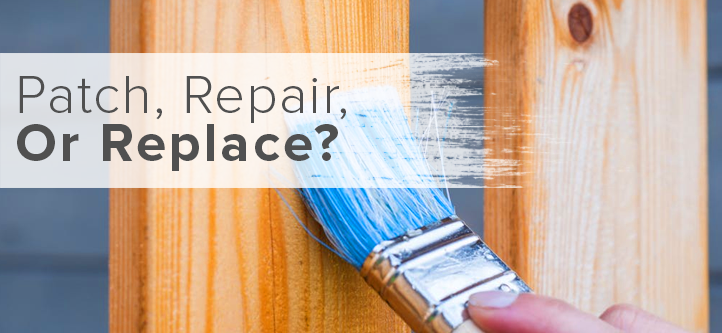When it comes to a fix and flip, the bigger the profit the better.
While any good investor wants to build a truly valuable, efficient, and functional home, any smart investor wants to spend as little as possible. To reconcile these competing goals, investors need to know when to patch a problem with a quick fix and when to replace something entirely.
What to Patch
Oftentimes, seemingly glaring issues can be resolved with a quick paint job or powerwash, both of which can be done cheaply. For old, worn exterior or interior walls, you can grab some paint and tools from the hardware store and get right to work. Just remember to choose neutral colors that will work with nearly any palette.
A good first impression is immensely important, but that doesn’t mean you need to spend a fortune on the house’s exterior. Make the front door stand out with a (slightly) bolder color than you chose for the house, update it with a shiny new doorknob and a small window. Simply cleaning the front yard and cutting down overgrown trees and bushes is a quick and cost effective way to give the house a fresh and tidy look. However, don’t be miserly here: while quick fixes are often practical, you don’t want to sacrifice your property’s appearance in the name of saving pennies. In some cases, it may be wise to do away with a crack-ridden walkway or replace a crumbling porch.
It’s amazing what a good cleaning can fix. Before you jump to replacing decrepit-looking siding or gutters, rent a power washer and see how much of that is just dirt and surface wear. A quick wash could end up saving you hundreds (or thousands) in replacement expenses.
A thorough cleaning of the house’s bathrooms could also prove immensely fruitful. Often, bathroom tiles, tubs, toilets, and sinks are extremely resilient. Depending on the look you are going for, working hard to scrub off the stains and re-grout the tiles (and replace any broken ones) may remove the need to spend a fortune there.
The absolute quickest of fixes is tidying up right before any potential buyers come to see the house. Give a quick sweep to any porches, decks, or walkways, and pick up any loose debris sitting around the property. Buyers who walk in happy are more likely to leave happy.
What to Repair
If a patch won’t quite cut it but you aren’t ready to rip the old out and bring in the new, there are a lot of repairs that you can make to save some cash.
One thing that can almost always be repaired for a profit is a good hardwood floor. Depending on the shape it’s in, repairing a hardwood floor may get pretty costly – it may even end up costing more than some replacements. However, maintaining the original hardwood flooring will be a big value added proposition for potential buyers. It has charm, it has value, and it has durability.
Another way to preserve charm is to try and save the windows. If the glass is of a good quality, you can often rip it out and repair a lot of wear and tear. While this is a longer process than simply buying new windows, the original glass has a lure similar to that of the original hardwood floors. If the glass can’t be saved, consider adding a newer, larger window: bringing more light into a space will make it much more appealing.
Cabinets and certain appliances can be fixed quickly and easily in many cases. Giving them a facelift with new and matching doors and surfaces makes them look brand new but saves you big bucks.
If cleaning the bathroom doesn’t cut it for you, some quick alterations could be all you need to spruce it up. When the old tile cannot be saved, don’t jump to tearing it out right away. It’s possible to add new tile, vinyl, or wood over the tile without ripping it out. In addition, you can add or replace shower doors and toilet seats without replacing the whole thing. However, keep in mind that the quality of your bathrooms will have a major impact on your house’s final price. Just like the home’s exterior, if the bathroom is in bad shape, this is not the place to cut corners and pinch pennies.
What to Replace
While most everything can be fixed, that doesn’t mean that everything should be. Sometimes, the increase in value your home will get from splurging on brand new features is worth it.
One way to increase the buyer’s comfort level, and the external appearance of the home, is to replace the roof. Although not always necessary, the ability to assure potential buyers that the roof over their heads in new and safe will be a relief to them, and that may turn into profit down the road.
Adding new landscaping is another way to get buyers excited about a home’s potential. It’s inexpensive, but some new mulch and shrubbery make the property much more attractive. However, don’t bother with expensive, exotic flowers. Stick with local varieties that are cheap, low maintenance, and long-lasting.
New light fixtures are also often worth the investment. Not only are they relatively simple to replace, but upgrading to LEDs for just a little more will let you advertise your property as energy efficient. Plus, potential buyers will be happy to hear that the bulbs don’t need to be replaced. When picking out new fixtures, choose pieces that fit well with the home’s design and buyers will notice.
Appliances are also a big opportunity for investors. If the home already has up-to-date appliances that are easily repaired, that’s great. However, odds are the appliances are old and clunky and lack many of the features that newer versions offer. Investing here could give big returns later. While these locations give proportionately large returns on investments: just make sure that you’re not going overboard. Remember: kitchens and bathrooms sell houses.
Keep in mind that, in the end, the decision to patch, repair, or replace depends on the state of the property and your goals for the remodel. Often, this will depend on the neighborhood you are in, the historic value of the house, and the likely buyers’ profiles. Use these tips as a jumping off point, but make decisions on a case-by-case basis. If you’re not sure whether to save or scrap, call in a professional. It may cost more in the moment, but it will pay off in the end.
Need help funding your renovations?
ABL funds 100% of the renovation cost for a fix and flip!
Pre-Qualify Today







0 Comments